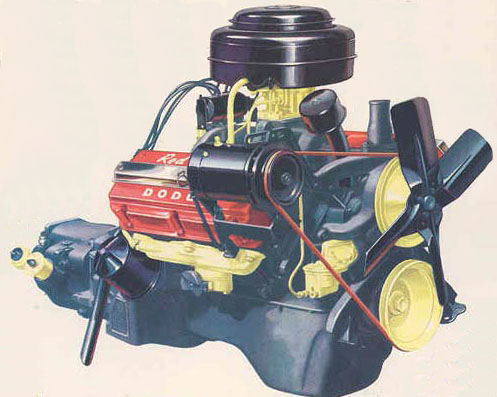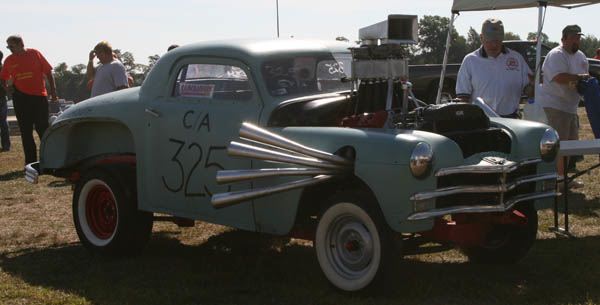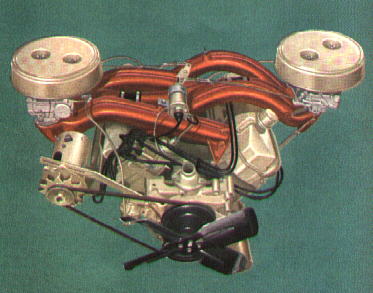A Little Horsepower History
In 1951, Chrysler offered their first V8 engine for passenger car service. It was a small-block design with a
![]()

1953 Dodge Red Ram Hemi
Over the next few years, DeSoto, Dodge and Imperial offered their own versions of the Hemi. The modified Hemis in 1956 and 1957 Dodge D-500, D-500-1 and D-501 were targeted directly at the performance-minded buyer. As
In 1958 the Hemi was dropped from Dodges and DeSotos (Plymouth never offered a small-block Hemi), in favor of a wedge-shaped combustion chamber in Chrysler's new big-block 'B' V8 engines as well as small-block polyspherical 'A' V8 engines (sometimes called the "semi-hemi", later replaced by the small-block wedge LA, or Light A
In 1960 and 1961, high-performance big-block Wedges could be fitted with a set of wild 30" intake manifold runners that crossed over the top of the engine. The left bank of cylinders were fed by a 4-bbl carb that hung to the right of the of the right bank of cylinders, and the right bank were fed by a carb hanging to the left of the left bank. This so-called "Ram Induction", invented by the Ramchargers car club of Dodge Engineers on
It should be noted that almost all automobiles built today employ forms of this tuned-resonance induction

The 'High & Mighty' 1949 Plymouth, © maxwedge.com

'High & Mighty' Ram Induction
with tuned radiator hoses for air intake, © maxwedge.com

1960 Dodge D-500 'Long Ram'
Meanwhile, Chrysler engineers were busy making plans for a Maximum Performance package, targeted at stock car racing and drag racing. As early as 1959, tests were being conducted on long-ram and short-ram inducted 413

1964 Stage III Ram-Charger 426
Beginning around April of 1962, Dodge and Plymouth offered the first Maximum Performance Wedge (nicknamed Max Wedge) in their new, light, mid-sized cars. The '62 Max Wedge had a 413 cubic inch engine. The engine was enlarged to 426 c.i. for 1963 and 1964. The Max Wedge package, which included many drivetrain and chassis modifications, was available in all 1962, 1963 and 1964 B-body Dodges and Plymouths (330, 440, '62 Dart, Polara, Polara 500, Savoy, Belvedere, Fury, Sport Fury), except 1962 station
Horsepower for the Max Wedges are as follows:
1962 413 11.0:1 compression ratio: 410 h.p.
1962 413 13.5:1 compression ratio: 420 h.p.
1963 426 11.0:1 compression ratio: 415 h.p.
1963 426 13.5:1 compression ratio: 425 h.p.
1964 426 11.0:1 compression ratio: 415 h.p.
1964 426 12.5:1 compression ratio: 425 h.p.
Max Wedges dominated drag racing during the early to mid 1960s. The fact that they are still competitve in
It can be argued that part of the Max Wedge appeal is that they were the fastest cars of their day, but, by most accounts, they didn't look the part. Some people find them downright ugly. Their outward appearance is

The following is from the 1962 booklet, "Salesman's Facts About The Dodge Dart Ram-Charger 413 V-8 High-
The Ram-Charger is one of the hottest power plants ever produced on an American assembly
line. It includes entirely new high-performance exhaust manifolds, valves and valve gear,
cylinder heads, pistons and rings, carburetors, ignition, transmission, and suspension
components. These specially engineered features, combined with top engine displacement, put
the new Ram-Charger chassis well out in front of all the new performance models.
Every time you plagiarize, God kills a kitten.
This booklet tells why it is an extraordinary engine, and how it can be adapted to the
special requirements of high-performance driving.
RAM-CHARGER 413 V-8 High-Performance Features
The Ram-Charger uses many special engine parts which are specifically engineered and
manufactured to provide the extra stamina needed in organized competitive driving.
Special drive-line and suspension features are included. These give superb sports-
car-like traction and handling characteristics which surpass even those of the standard
Dart.© maxwedge.com
o SHORT-RAM INTAKE MANIFOLD
This new ram-induction intake manifold substantially increases power output in the
competitively important ranges above 4,000 r.p.m. A series of short (15-inch) ram
tubes fit between the rocker covers. Tappets can be adjusted with the manifold
installed -- an important servicing advantage.© maxwedge.com
o EXTRA-LARGE VALVES
Intake valves (2.08-inch diameter) are streamlined for higher air flow. Exhaust
valves are made of high heat-resistant alloy. They are 1/4-inch larger than
standard, providing greatly improved exhaust flow. Head gaskets are of stainless
steel for extra durability© maxwedge.com
o SPECIAL CYLINDER HEADS
The port areas of each head are about 25 percent larger than standard for better
engine breathing. The exclusive deck structure provides extra-strong gasket
sealing to handle the extreme pressures built up in top-performance operation. The
heat crossover passage has been eliminated, for greater volumetric efficiency
under competitive conditions.© maxwedge.com
o OVERSIZED EXHAUST SYSTEM
The streamlined cast-iron exhaust manifolds are of the long branch type for
greater volumetric efficiency. They have three-inch outlets, with cutouts for
minimum back pressure. Each tailpipe is two inches in diameter.© maxwedge.com
o HIGH-CAPACITY CARBURETOR
This includes two four-barrel Carter carburetors, with hand choking. Air cleaners
are of the dry type for high-volume intake combined with optimum filtering
effectiveness.© maxwedge.com
o NEW FUEL PUMP
Three valves provide extra pumping capacity. High spring load provides higher fuel
pressure.© maxwedge.com
o FORGED ALUMINUM PISTONS
Forging provides more strength than is possible with the usual casting process.© maxwedge.com
o PISTON RINGS
The top compression ring is chrome-plated, high-strength iron for scuff
resistance. Number two ring is of standard design. Number three ring is a
two-piece design, specially adapted to the lubrication requirements of this engine.© maxwedge.com
o CONNECTING RODS
These are magnaflux-inspected. This assures maximum dependability under extreme
stress.© maxwedge.com
o OIL PAN
It is equipped with anti-slosh baffles. This feature assists positive lubrication
under maximum take-off and top-performance conditions.© maxwedge.com
o SPECIALLY DESIGNED VALVE GEAR
Mechanical valve lifters replace the standard hydraulic design, to eliminate
pump-up at high engine speeds. New high-strength valve-spring retainers and double
high-load valve springs are installed to control valve "float" at high r.p.m.
Rocker arms include a lock nut on the lash-adjusting screw for easier, more
precise adjustments. The valve gear is rated stable to 6,500 r.p.m. on the
standard test fixture.© maxwedge.com
o DEEP-GROOVE PULLEYS© maxwedge.com
All belt pulleys are deep-groove for better belt retention at high speeds.© maxwedge.com
o CRANKSHAFT© maxwedge.com
Hardened journals, with tri-metal bearings that add additional bearing-load
capacity, enable the crankshaft to withstand the extra strains produced by the
Ram-Charger's exceptionally high power output.© maxwedge.com
o IGNITION FEATURES© maxwedge.com
A special distributor, of full -centrifugal -advance design, has a new cam and a
dual-breaker system. The special cam and a high spring load on the points prevent
"point bounce". The dual-breaker system results in increased plug voltage at high
speeds. Special lowresistance cables and cold-running spark plugs are designed for
high engine power output.© maxwedge.com
o SPECIAL MANUAL TRANSMISSION© maxwedge.com
This new floor -shift three -speed gearbox is specifically engineered for maximum-
performance work. New shafts, shot-peened gears and extensions give added
strength. The outstanding engine power permits closely spaced gear ratios of 2.10,
1.45 and 1 to 1. Other heavy-duty features include a 10 1/2-inch clutch, pearlitic
malleable-iron pressure plate, extra-heavyduty torque shaft, and special disc. The
housing is of aluminum to save weight.© maxwedge.com
o HIGH-EFFICIENCY AUTOMATIC TRANSMISSION© maxwedge.com
The optional heavy-duty Torque-Flite transmission has pushbutton controls and
special high-capacity components. It is set to upshift at engine speeds of up to
5,600 r.p.m. Maximum torque -convertor ratio is 2.2 to 1. Planetary-gear ratios
are 2.45, 1.45 and 1 to 1. Maximum over-all "breakaway" ratio (5.39 to 1) and
general efficiency are the highest of any stock automatic transmission.© maxwedge.com
o DRIVESHAFT© maxwedge.com
This is specially balanced for extra-fast acceleration and high running speeds.© maxwedge.com
o HEAVY-DUTY REAR SPRINGS© maxwedge.com
A stiffer spring rate helps absorb the extremely high torque developed by the
Ram-Charger engine.© maxwedge.com
o "SURE-GRIP" REAR AXLE© maxwedge.com
Standard equipment, this feature provides top traction for both wheels. Standard
ratio is 3.91 on both transmissions. Other ratios, for special driving
requirements, range from 2.93 through 4.89. They are available in ring-and-pinion
sets through Dodge dealers.© maxwedge.com
o WHEELS AND TIRES© maxwedge.com
Standard tires are 7.50 x 14" tubeless Tyrex cord, front and rear. For
exceptionally rugged requirements, long life, and greater road grip, 6 1/2 K
(rim-width size) rear wheels and 9.00 x 14" rear tires are offered as dealer
-installed options.© maxwedge.com
RAM-CHARGER 413 V-8 OPERATING CHARACTERISTICS© maxwedge.com
Like any thoroughbred performer, the Ram-Charger has a strong personality. This gives it
certain mechanical traits very different from those of ordinary engines. Here are some
of these traits, the reasons for them, and some suggested adjustments to them.© maxwedge.com
o GAS AND OIL MILEAGE© maxwedge.com
In a high -performance precision engine, oil cleanliness is a must. So engine oil
should be changed every 1,000 miles -- and more often in dusty areas.© maxwedge.com
Since carburetors and axle ratios are designed for maximum power rather than for
outstanding economy, good gas mileage cannot be reasonably expected.© maxwedge.com
Adequate lubrication at very high engine speeds is accomplished by eliminating
valve-stem seals and by using low-friction, wide-clearance piston rings. These
special features result in somewhat higher oil consumption than is found in
ordinary power plants.© maxwedge.com
o ENGINE IDLING© maxwedge.com
The long-duration camshaft provides maximum power output at the expense of smooth
idling and low-speed response. Similarly, increased piston clearance and the
special valve mechanism allow dependable highspeed operation, but sacrifice some
of Dodge's customary engine quietness.© maxwedge.com
o COLD-WEATHER DRIVING© maxwedge.com
This engine is designed primarily for the elevated operating temperatures
generated by performance driving. That's why heating arrangements have been
removed from the intake manifold. During cold-weather operation, the resulting
tendency toward carburetor icing and delayed warm-up can be combatted by partially
covering the radiator, using a gasoline with anti-icing additives, and allowing
the car to stand for a few minutes with the engine off after the water temperature
is up to normal.© maxwedge.com
o FREQUENT CHECKING PAYS OFF© maxwedge.com
For finest performance, the ignition system should be kept in top-notch condition.
So it's advisable to inspect, adjust and replace spark plugs and ignition points
at fairly frequent intervals.© maxwedge.com
Automatic transmission shifting bands require frequent checking and adjustments
for maximum performance and long life.© maxwedge.com
RAM-CHARGER 413 V-8 MAXIMUM-PERFORMANCE CAPABILITIES© maxwedge.com
When the car is to compete in approved acceleration trials, a little extra attention to
details can often bring a decisive edge in performance and lengthen the life of the
engine.© maxwedge.com
o HELPFUL HINTS© maxwedge.com
To open exhaust outlets to the atmosphere (when rules permit) the standard exhaust
cutout can be used, bypassing the muffler and tailpipe assembly.© maxwedge.com
For better suspension control during fast starts, additional spring clips can be
used to tie the ends of each leaf to the rest of the spring.
Air pressure in the front tires may be increased, to lessen rolling resistance.
Tires of high butyl content can be used on the rear, to give best traction on most
surfaces.© maxwedge.com
o FOR ADDED PERFORMANCE AND PROTECTION© maxwedge.com
Valve lash, spark plugs and timing should be checked frequently to let the
Ram-Charger operate consistently at peak efficiency. The highest octane fuel
available (102 or higher) must be used. Front-end alignment should be set
correctly. Brake shoes can be adjusted to eliminate any possible brake drag.
A word of caution: to protect the fine working parts of the engine, it should not
be run over 6500 r.p.m. And it's necessary to limit wideopen throttle bursts to
fifteen seconds duration.© maxwedge.com
Serious competition in all-out performance contests offers additional opportunities to
bring this engine to a peak of perfection. Here are some ways by which the Ram-Charger
can be made a top contender in highly competitive acceleration trials.© maxwedge.com
o FUEL SYSTEM© maxwedge.com
Two electric fuel pumps can be installed for faster feeding, Since the carburetors
have been factory-set for maximum-power fuel-air ratio, no experimenting with them
is necessary.© maxwedge.com
o DRIVE LINE© maxwedge.com
Faster shifting with the manual transmission can be achieved by installing a
spring-loaded straight-through shifting mechanism (HurstCampbell or comparable
device). And a higher numerical axle ratio will enable the engine to reach its
power peak before the car reaches the end of a performance run.© maxwedge.com
o COOLING© maxwedge.com
Cool air can be routed to the carburetors by whatever means competition rules
allow. A smaller fan can be installed to ease the load on the engine when weather
permits.© maxwedge.com
o SPARK PLUGS© maxwedge.com
The standard Champion J9Y plugs should be set at .025" electrode gap.© maxwedge.com
o VALVE ADJUSTMENT© maxwedge.com
Valve spring heights should be set to the proper specifications.© maxwedge.com
o SUSPENSION AND BRAKING© maxwedge.com
Optional rear wheels can be used. The pinion bumper .should be contacting the
floor pan when the car is at its ready-to-run height. Heavyduty rear shock
absorbers can be used for optimum wheel control. An optional right rear spring
installation will improve traction. The automatic brake adjusters may be removed
and the brakes kept adjusted manually.© maxwedge.com
o OPERATING TIPS© maxwedge.com
Experimenting with tire size, compound and pressure -- combined with sharp
starting techniques -- will help achieve top performance. And a final word of
warning: the 13.5:1 - compression- ratio engine must never be run at top speeds
for more than fifteen seconds at a time.© maxwedge.com
RAM-CHARGER 413 V-8 GENERAL SPECIFICATIONS© maxwedge.com
The Ram-Charger 413 is not only a high-performance engine that is second to none in
stock-car ranks, it is an entire automobile designed especially for competitive-type
driving -You'll see in the information listed below.© maxwedge.com
o ENGINE© maxwedge.com
Piston displacement, cu. in.............................. 413© maxwedge.com
Bore and stroke, in...............................4.19 x 3.75© maxwedge.com
Compression ratio................................(13.5 to 1*)© maxwedge.com
Horsepower.........................................410 (420*)© maxwedge.com
Torque, lb.-ft.....................................460 (470*)© maxwedge.com
Carburetor.....................................Double. 4 bbl.© maxwedge.com
Cooling system...........................17 qts., with heater© maxwedge.com
Crankcase capacity (oil)...............4 qts., plus 1 qt. for© maxwedge.com
filter when it is changed.© maxwedge.com
(*Maximum-performance option)© maxwedge.com
o TRANSMISSIONS© maxwedge.com
Standard 3-speed heavy-duty manual, floor shift. Ratios: 2.10, 1.45, 1 to 1.© maxwedge.com
Optional 3-speed automatic heavy-duty Torque-Flite. Water cooled. Ratios: 2.45,
1.45, 1 to 1.© maxwedge.com
o EXHAUST© maxwedge.com
3" Dual. Aluminized muffler and tailpipe.© maxwedge.com
o AXLE RATIOS (Sure-Grip differential standard)© maxwedge.com
Standard - 3.91 to 1.© maxwedge.com
Optional - 2.93, 3.23, 3.55, 4.10, 4.30, 4.56, 4.89 to 1.© maxwedge.com
o ELECTRICAL© maxwedge.com
Alternator - 35-amp, 6-diode© maxwedge.com
Battery - 12-volt, 59 amp-hr. rating© maxwedge.com
o SUSPENSION© maxwedge.com
Torsion bar, front© maxwedge.com
Leaf, rear (heavy-duty) 55" x 2 1/2" - 6 leaf.© maxwedge.com
Shock absorbers - Oriflow, hydraulic, double-acting, telescopic.© maxwedge.com
o BRAKES© maxwedge.com
Lining area - 195.2 sq. in. Internal expanding, duo-servo, self energizing,
selfadjusting.© maxwedge.com
o TIRES© maxwedge.com
Standard -- 7.50 x 14" Tyrex cord.© maxwedge.com
Optional -- 9.00 x 14" rear.© maxwedge.com
o FUEL TANK CAPACITY© maxwedge.com
20 gallons.© maxwedge.com
o STEERING GEAR RATIOS© maxwedge.com
Manual - 24 to 1. 5.3 turns, full right to full left.© maxwedge.com
o TURNING DIAMETER© maxwedge.com
Curb-to-curb, 40.3 ft.© maxwedge.com
o WHEELBASE© maxwedge.com
116 in.© maxwedge.com
o COMPRESSION RATIO© maxwedge.com
Combustion chamber volume:© maxwedge.com
Minimum 83 cc© maxwedge.com
Maximum 86 cc© maxwedge.com
To reduce the volume of the combustion chamber 1 cc, .005" must be milled from the
head surface. For each 0.01" removed from the cylinder head, 0.0122" must be
removed from the intake side of the head.© maxwedge.com
Distance from the top of the lower flat of the piston to the block deck:
11:1 C.R. 13.5:1 C.R.
Minimum .0155" .018"
Maximum .0455" .043"© maxwedge.com
o BOLT AND NUT TORQUES© maxwedge.com
Cylinder head bolts, 75 lbs. ft.
Main bearing bolts, 85 lbs. ft.
Connecting-rod nuts, 45 lbs. ft.
Intake manifold bolts, 30 lbs. ft.© maxwedge.com
o CLUTCH FREE-PLAY ADJUSTMENT© maxwedge.com
Minimum 1/2"
Maximum 3/4"
o AXLE SHAFT END PLAY© maxwedge.com
Minimum .013"
Maximum .023"© maxwedge.com
o OIL© maxwedge.com
Any name-brand oil "For Service MS" may be used.© maxwedge.com
o FUEL PUMP PRESSURE
© maxwedge.com
6-8 p.s.i. at 1500 r.p.m. engine idle.© maxwedge.com
o ENGINE IDLE© maxwedge.com
Speed - 1000 r.p.m.© maxwedge.com
Vacuum - 10 inches of mercury.
o AUTOMATIC TRANSMISSION LINE PRESSURE© maxwedge.com
105 p.s.i.
o VALVE LASH© maxwedge.com
Intake Exhaust
Cold Cold
Normal driving .026" .032"
Acceleration trials .026" .032"© maxwedge.com
o IGNITION
© maxwedge.com
Spark Plugs:
Electrode Gap -- .025"
Comp. Ratio 11:1 -- J9Y
Comp. Ratio 13.5:1 -- J79© maxwedge.com
Ignition point gap - .018" or .014"-.0191" dwell.
Timing-36° at 3,000 r.p.m. or 120 at 800 r.p.m.© maxwedge.com
o PISTON CLEARANCES© maxwedge.com
Comp. Ratio Comp. Ratio
11:1 13.5:1
Normal driving..........0035"-.0045"
Acceleration trials.....0035"-.0045" .008"-.010"
o PISTON RING END GAP
.013" - .035"
o VALVE SPRING HEIGHTS
Minimum - 1.83" Maximum - 1.86"
o BEARING CLEARANCES
Main bearings, .001" -.0035"
Connecting-rod bearings, .001" - .0035"
RAM-CHARGER 413 V-8 GENERAL INFORMATION© maxwedge.com
The Ram-Charger engine is for automotive enthusiasts only. The special thrills of owning
it are reserved for the relative few who can appreciate and properly care for the finest
kind of high -performance stock automobile.
o BREAK-IN PERIOD© maxwedge.com
This is the same as on the standard Dart (see owner's Manual) except that oil
should be changed every 1,000 miles.
o SPECIAL PARTS READILY AVAILABLE© maxwedge.com
A full complement of precision parts are available through Dodge dealers. Dealers
can write or telegraph Chrysler Motors Corporation, Centerline Parts Plant, 7000
E. 11 Mile Road, Centerline, Michigan, P.O. Box 300 -or phone JE 9-3000, extension
7593.© maxwedge.com
o NOTE:© maxwedge.com
If this engine is to be used in acceleration trials, participation must be limited
to events sponsored by a nationally established governing organization.
